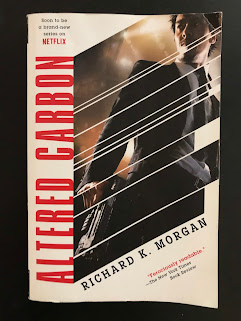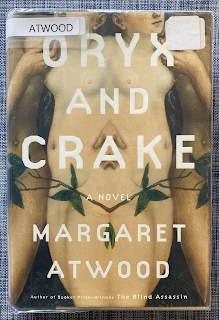Altered Carbon - Richard K. Morgan
Altered Carbon follows Takeshi Kovacs, an ex-supersoldier, who gets stuck in a body on Earth to do some good ol' fashioned detective work. He is tasked with investigating the suicide of Laurens Bancroft, a Meth (short for the long-lived Biblical figure Methuselah). Detailed gore, gunfights, sex, and intrigue ensue. I sometimes struggled through the more gruesome or explicit passages in the book, but they certainly are engaging.
Bancroft, along with several other characters in the story, take massive advantage of "altered carbon," a technology that allows human consciousness to be saved and stored as data. All people have this storage available, but Meths are the super-rich and powerful who can have cloned bodies ready to roll at any time (barring a quick download of their mind), and can afford to have backups of their minds in case their bodies are utterly destroyed. This means that Meths never die, and the ones we meet in the story are hundreds of years old. Even for non-Meths, thanks to altered carbon, everyone has a way around death; the book explores ramifications such as how the police investigate murder, how one can inflict real death by destroying someone's data storage, and how religion can make people abandon their immortal stored selves. This deathlessness also leads to the central plot: Bancroft is still alive to hire Kovacs for his investigation.
I found the plot enthralling. The most satisfying part for me was the extensive crafting of callbacks. Most plot points that appear through the book, and initially feel like off-hand remarks or worldbuilding, turn out relevant to the plot or characters' motivations later on. The script is tight, with absolutely nothing wasted, as long as you're willing to wait a couple hundred pages for the reward.
In terms of race and sexuality, this book can feel a little dated in 2020. This is due to the throwaway nature of human bodies in the Altered Carbon universe; one's consciousness can be stored and ported between bodies, so race, gender, and physical identity are mutable and impermanent. The end effect is a callous labeling of people by racial archetypes. However, these archetypes never devolve into stereotypes, and the blunt language makes sense in the context of the story. Still, characters' races tend to be described only when they are non-white. In terms of sexuality, all detailed encounters in the book are heteronormative, but the author does make some space for people of indeterminate gender, and explores the experience of swapping between bodies of different genders and sexualities. The author also explores dark fetishes made possible by altered carbon. So, pretty progressive for 2002, but perhaps dated for 2020.
The best part of the book to me is that there are no real heroes or villains. Everyone is just trying to get by, scheming with limited knowledge, and making sometimes horrifying choices as a result. It's often hard to root for Kovacs, despite his role as the protagonist. He is wracked by PTSD and a history of violence, making him merciless and brutal. And yet, he is kind and gentle in unexpected places, keeping the reader emotionally engaged. Each main character feels similarly fleshed out.
Altogether, I really enjoyed this book. The tight plot, extensive world-building, and complex characters create a rich, lush story to dive into headfirst.


Comments
Post a Comment